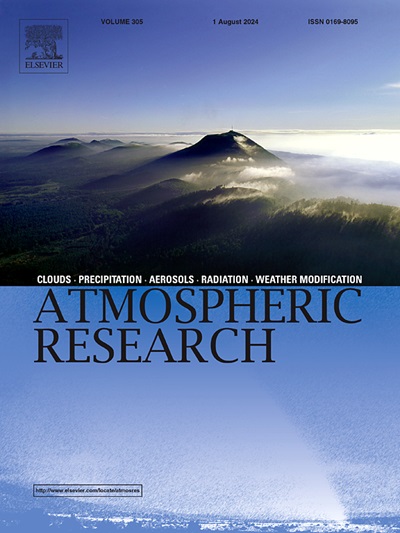Recent decades witness a strong east-west gradient of monsoon precipitation changes over Northern India
IF 4.5
2区 地球科学
Q1 METEOROLOGY & ATMOSPHERIC SCIENCES
引用次数: 0
Abstract
Changing climate has substantially altered the spatio-temporal rainfall pattern, especially over the Indian subcontinent where the Indian Summer Monsoon (ISM) predominates from June to September. This study explores the changes in the rainfall variability over Northern India (NI) for the period 1981–2020 and this region exhibits topographic diversity, encompassing arid Northwestern India (NWI) due to desert conditions with minimal rainfall and the rainfall-intensive region in the Indo-Gangetic Plains (IGP). In recent decades, a dipolar rainfall pattern has been observed over NI, characterized by a significant increase (reduction) in mean as well as intense rainfall over NWI (IGP). Rainfall intensity over the IGP has decreased by 10.2 %, 7.6 %, and 12 % at the 95th, 99th, and 99.9th percentiles, respectively, while the NWI has increased by 15 % and 9 % at the 95th and 99th percentiles, with a slight 0.17 % decline at the 99.9th percentile. These changes can be attributed to an increase in the frequency of monsoon depressions by about 46 % over the Arabian Sea (AS), while the Bay of Bengal (BoB) has experienced about 32 % decrease. Moreover, increased precipitation in the NWI is characterized by enhanced moisture transport and convergence, a robust low-level jet, unstable atmospheric conditions leading to strong convection. Conversely, the IGP experiences lower moisture transport and convergence, more stable atmospheric conditions, and consequently, reduced precipitation. Furthermore, this study utilizes the Detection and Attribution Model Intercomparison Project of CMIP6 data to investigate the influence of aerosols, greenhouse gases (GHGs), and natural forcings on precipitation patterns. The results reveal a similar dipole spatial pattern of rainfall due to increased aerosol concentration, indicating the role of aerosols in shaping the ISM rainfall patterns. We further employ Weather Research and Forecasting model coupled with Chemistry (WRF-Chem) to assess how aerosol loadings impact ISM characteristics.

求助全文
约1分钟内获得全文
求助全文
来源期刊

Atmospheric Research
地学-气象与大气科学
CiteScore
9.40
自引率
10.90%
发文量
460
审稿时长
47 days
期刊介绍:
The journal publishes scientific papers (research papers, review articles, letters and notes) dealing with the part of the atmosphere where meteorological events occur. Attention is given to all processes extending from the earth surface to the tropopause, but special emphasis continues to be devoted to the physics of clouds, mesoscale meteorology and air pollution, i.e. atmospheric aerosols; microphysical processes; cloud dynamics and thermodynamics; numerical simulation, climatology, climate change and weather modification.
 求助内容:
求助内容: 应助结果提醒方式:
应助结果提醒方式:


